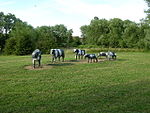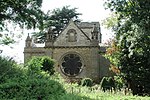Wolverton

Wolverton is a constituent town of Milton Keynes, England. It is located in the north-west of the city, beside the West Coast Main Line, the Grand Union Canal and the river Great Ouse. It is the administrative seat of Wolverton and Greenleys civil parish. It is one of the places in historic Buckinghamshire that went into the foundation of Milton Keynes in 1967. The village recorded in Domesday is known today as Old Wolverton but, because of peasant clearances in the early 17th century, only field markings remain of the medieval settlement. Modern Wolverton is a new settlement founded in the early 19th century as a railway town, with its centre relocated about 1 km (0.6 mi) to the southeast.
Excerpt from the Wikipedia article Wolverton (License: CC BY-SA 3.0, Authors, Images).Wolverton
Radcliffe Street, Milton Keynes Old Wolverton
Geographical coordinates (GPS) Address Nearby Places Show on map
Geographical coordinates (GPS)
| Latitude | Longitude |
|---|---|
| N 52.06265 ° | E -0.8102 ° |
Address
Radcliffe Street
Radcliffe Street
MK12 5SB Milton Keynes, Old Wolverton
England, United Kingdom
Open on Google Maps









